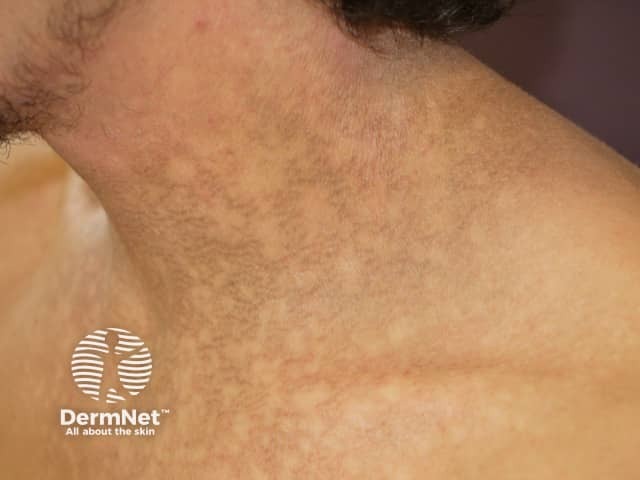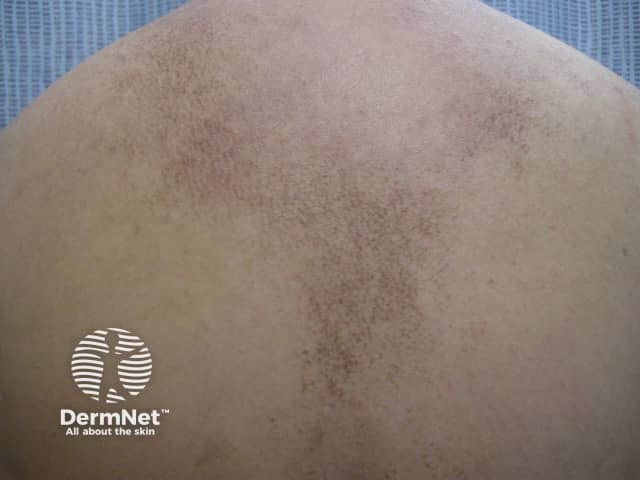Main menu
Common skin conditions

NEWS
Join DermNet PRO
Read more
Quick links
Confluent and reticulated papillomatosis — extra information
Confluent and reticulated papillomatosis
Author: Vanessa Ngan, Staff Writer, 2005. Latest update Dr Thomas Stewart. DermNet Editor in Chief: A/Prof Amanda Oakley, Dermatologist, Hamilton, New Zealand. Copy edited by Gus Mitchell. April 2018.
Introduction Demographics Causes Clinical features Differential diagnoses Diagnosis Treatment Outlook
What is confluent and reticulated papillomatosis?
Confluent and reticulated papillomatosis is an uncommon skin condition affecting the trunk, neck and axillae. It is characterised by asymptomatic, hyperpigmented papules and plaques that have a peripheral, net-like configuration.
French dermatologists Gourgerot and Carteaud first described confluent and reticulated papillomatosis in 1927 [1].

Confluent and reticulated papillomatosis

Confluent and reticulated papillomatosis

Confluent and reticulated papillomatosis
Who gets confluent and reticulated papillomatosis?
Confluent and reticulated papillomatosis mostly occurs in young adults. The mean age of incidence is 15 years, with a range of 8–32 years [2]. It has been reported worldwide in all racial groups and ethnicities, but it is reported to be most common in Caucasians [3].
What is the cause of confluent and reticulated papillomatosis?
What triggers confluent and reticulated papillomatosis remains unclear. Disordered and hyperproliferative keratinisation has been observed on light and electron microscopy [4,5]. The possibility that this is due to skin infection is supported by the success of treatment with antibiotics.
- Dietzia papillomatosis is the current leading infectious candidate. This is a gram-positive actinomycete that was first isolated from a patient with confluent and reticulated papillomatosis in 2005 [5,6].
- Earlier observations that antifungal agents were effective, supporting the role of Malassezia furfur in the pathogenesis, were likely due to misdiagnosis of pityriasis versicolor [2,8].
Genetic factors may also be involved.
- Several cases of familial confluent and reticulated papillomatosis have been reported [9,10].
- Mutation of the gene for the protein keratin-16 (K-16) has been found in some cases [11].
Insulin resistance, which causes diabetes mellitus and polycystic ovarian syndrome, has been suggested as a contributing factor to confluent and reticulated papillomatosis, but evidence is weak, as most affected patients do not have metabolic syndrome [12,13].
Amyloidosis and reaction to ultraviolet light have also been considered but are unlikely causes [14,15].
What are the clinical features of confluent and reticulated papillomatosis?
Confluent and reticulated papillomatosis is characterised by multiple 1–5 mm, hyperpigmented, scaly macules or papillomatous papules.
- These often form confluent patches or plaques centrally, and a reticular pattern peripherally.
- They most commonly occur on the upper trunk, neck and axillae. They may also extend anteriorly down to the pubic region and posteriorly to the natal cleft. The antecubital and popliteal fossae and forehead are rarely affected [16–18].
- The eruption does not involve mucosal surfaces or nails.
- Lesions are asymptomatic or mildly itchy.
What is the differential diagnosis of confluent and reticulated papillomatosis?
The most common conditions that mimic the morphology and/or distribution of confluent and reticulated papillomatosis are:
- Acanthosis nigricans, which is associated with obesity and insulin resistance. Pigmentation is not associated with peripheral reticulation [19].
- Pityriasis versicolor, which has positive microscopy and clears with antifungal treatment.
Less common disorders that may need to be considered in the differential include:
- Darier disease
- Dowling-Degos disease and Galli-Galli disease
- Epidermal naevus
- Epidermodysplasia verruciformis
- Plane warts
- Dyskeratosis congenita
- Prurigo pigmentosa
- Dermatitis neglecta
- Terra firma-forme dermatosis
- Lichen or macular amyloidosis.
How is confluent and reticulated papillomatosis diagnosed?
The diagnosis of confluent and reticulated papillomatosis is based on identifying typical clinical features and excluding fungal infection by microscopy and culture of scale (see mycology of dermatophyte infections).
Davis et al have proposed a set of diagnostic criteria for confluent and reticulated papillomatosis [2].
- Clinical findings are scaly brown macules and patches, at least part of which appear reticulated and papillomatous.
- The rash affects the upper trunk and neck.
- Microscopy and culture of scales are negative for fungus.
- The rash does not respond to antifungal treatment.
- It has an excellent response to minocycline.
This set of criteria has shown good concordance with other large case series [19].
Skin biopsy may be indicated to exclude other diagnoses.
What is the treatment for confluent and reticulated papillomatosis?
Confluent and reticulated papillomatosis usually clears with a tetracycline (minocycline, doxycycline for 6–12 weeks) or a macrolide antibiotic (azithromycin, clarithromycin, erythromycin for 4–6 weeks) [2,20,21]. Azithromycin and erythromycin can be prescribed in pregnancy [22–24]
Topical tazarotene (a topical retinoid), tacrolimus and calcipotriol may be used for localised disease [25–27].
Systematic retinoids (isotretinoin and acitretin) are usually reserved for cases refractory to antibiotics and topical agents [28].
What is the outlook for confluent and reticulated papillomatosis?
A single course of minocycline or a macrolide antibiotic is reported to lead to remission for up to 2 years in many cases of confluent and reticulated papillomatosis [2,21,29].
Recurrence in up to 15% of cases usually follows non-antibacterial treatment.
Spontaneous resolution has been reported in a few cases but it may take up to 39 months for the eruption to clear up [30].
References
- Gougerot H, Carteaud A. Papillomatose pigmentée innominée [Unclassified pigmented papillomatosis]. Cas pour diagnostic. Bulletin de la Société française de dermatologie et de syphiligraphie. 1927; 34: 712–19.
- Davis MDP, Weenig RH, Camilleri MJ. Confluent and reticulated papillomatosis (Gougerot-Carteaud syndrome): a minocycline-responsive dermatosis without evidence for yeast in pathogenesis. A study of 39 patients and a proposal of diagnostic criteria. Br J Dermatol. 2006; 154(2): 287–93. PubMed
- Scheinfeld N. Confluent and reticulated papillomatosis: a review of the literature. Am J Clin Dermatol. 2006; 7(5): 305. PubMed
- Jimbow M, Talpash O, Jimbow K. Confluent and reticulated papillomatosis: clinical, light and electron microscopic studies. Int J Dermatol. 1992; 31(7): 480–3. PubMed
- Griffith CE. Gougerot-Garteaud still an enigma after all these years. J Dermatolog Treat. 2003; 13(1): 1.
- Natarajan S, Milne D, Jones AL, Goodfellow M, Perry J, Koerner RJ. Dietziastrain X: a newly described actinomycete isolated from confluent and reticulate papillomatosis. Br J Dermatol. 2005; 153(4): 825–27. DOI: 10.1111/j.1365-2133.2005.06785.x. PubMed
- Jones AL, Koerner RJ, Natarajan S, Perry JD, Goodfellow M. Dietzia Papillomatosis sp. nov., a novel actinomycete isolated from the skin of an immunocompetent patient with confluent and reticulated papillomatosis. Int J Syst Evol Microbiol. 2008; 58(Pt 1): 68–72. DOI: 10.1099/ijs.0.65178-0. PubMed
- Roberts SOB, Lachapelle JM. Confluent and reticulate papillomatosis (Gougerot-Carteaud) and Pityrosporum orbiculare. Br J Dermatol. 1969; 81(11): 841–45. PubMed
- Baden HP. Familial cutaneous papillomatosis. Arch Dermatol. 1965; 92(4): 394–95. DOI:10.1001/archderm.1965.01600160050009. Journal
- Hulsbergen Henning JP, de Wit RF. Familial occurrence of confluent and reticulated papillomatosis. Arch Dermatol. 1981; 117 (12): 809–10. DOI: 10.1001/archderm.1981.01650120055023. Journal
- Inaloz HS. Familial confluent and reticulated papillomatosis. Arch Dermatol. 2002; 138(2): 276–7. DOI:10.1001/archderm.138.2.266. Journal
- Lim KB. Confluent and reticulated papillomatosis. Cutis. 1988; 41: 215–17.
- Hirokawa M, Matsumoto M, Iizuka H. Confluent and reticulated papillomatosis: a case with concurrent acanthosis nigricans associated with obesity and insulin resistance. Dermatology. 1994; 188(2): 148–51. DOI: doi.org/10.1159/000247122. PubMed
- Vassileva S, Pramatarov K, Popova L. Ultraviolet light-induced confluent and reticulated papillomatosis. J Am Acad Dermatol. 1989; 21(2/2): 413–4. PubMed
- Groh V, Schnyder UW. Papillomatosis. J Am Acad Dermatol 1989; 21 (2 Pt 2): 413–4.
- Lee D, Cho KJ, Hong SK, Seo JK, Hwang SW, Sung HS. Two cases of confluent and reticulated papillomatosis with an unusual location. Acta Derm Venereol. 2009; 89(1): 84–5. DOI: 10.2340/00015555-0552. PubMed
- Treat JR, Barak OG, James WD. Nonpigmenting confluent and reticulated papillomatosis. Pediatr Dermatol. 2006; 23(5): 497–9. DOI: doi.org/10.1111/j.1525-1470.2006.00292.x. PubMed
- Kim BS, Lim HJ, Kim HY, Lee WJ, Lee SJ, Kim DW. Case of minocycline-effective confluent and reticulated papillomatosis with unusual location on forehead. J Dermatol. 2009; 36(4): 251–3. DOI: doi.org/10.1111/j.1346-8138.2009.00634.x. Journal
- Lim JHL, Tet LH, Chong W. Confluent and reticulated papillomatosis: diagnostic and treatment challenges. Clin Cosmet Investig Dermatol. 2016; 9: 217–23. doi: 10.2147/CCID.S92051. PubMed
- Montemarano AD, Hengge M, Sau P, Welch M. Confluent and reticulated papillomatosis: response to minocycline. J Am Acad Dermatol. 1996; 34: 253–6. PubMed
- Huang W, Ong G, Chong WS. Clinicopathological and diagnostic characterization of confluent and reticulate papillomatosis of Gougerot and Carteaud: a retrospective study in a South-East Asian population. Am J Clin Dermatol. 2015; 16(2): 131–6. href="https://www.ncbi.nlm.nih.gov/pubmed/25589050" target="_blank">PubMed
- Gruber F, Zamolo G, Saftić M et al. Treatment of confluent and reticulated papillomatosis with azithromycin. Clin Exp Dermatol. 1998; 23(4): 191. PubMed
- Ozdemir S, Aktaş A, Aliağaoğlu C, Karakuzu A, Erdem T. Treatment of confluent and reticulated papillomatosis with azithromycin. Atasoy M, J Dermatol. 2004; 31(8): 682–6. PubMed
- Jang HS, Oh CK, Cha JH, Cho SH, Kwon KS. Six cases of confluent and reticulated papillomatosis alleviated by various antibiotics. J Am Acad Dermatol. 2001; 44(4): 652–5. PubMed
- Bowman PH, Davis LS. Confluent and reticulated papillomatosis: response to tazarotene. J Am Acad Dermatol. 2003; 48(5 Suppl): S80–1. PubMed
- Gülec AT, Seçkin D. Confluent and reticulated papillomatosis: treatment with topical calcipotriol. Br J Dermatol. 1999; 141(6): 1150–1. PubMed
- Tirado-Sánchez A, Ponce-Olivera RM. Tacrolimus in confluent and reticulated papillomatosis of Gougerot Carteaud. Int J Dermatol. 2013; 52(4): 513–4. PubMed
- Lee MP, Stiller MJ, McClain SA, Shupack JL, Cohen DE. Confluent and reticulated papillomatosis: response to high-dose oral isotretinoin therapy and reassessment of epidemiologic data. J Am Acad Dermatol. 1994 Aug; 31(2/2): 327–31. PubMed
- Angeli-Besson C, Koeppel MC, Jacquet P, Andrac L, Sayag J. Confluent and reticulated papillomatosis (Gougerot-Carteaud) treated with tetracyclines. Int J Dermatol. 1995 Aug; 34(8): 567–9. PubMed
- Sakiyama T, Amagai M, Ohyama M. Chronology of confluent and reticulated papillomatosis: spontaneous regression in a case after long-term follow-up may imply transient nature of the condition. J Dermatol. 2015; 42(3): 335–6. PubMed
On DermNet
Other websites
- Confluent and Reticulated Papillomatosis — Medscape Reference
